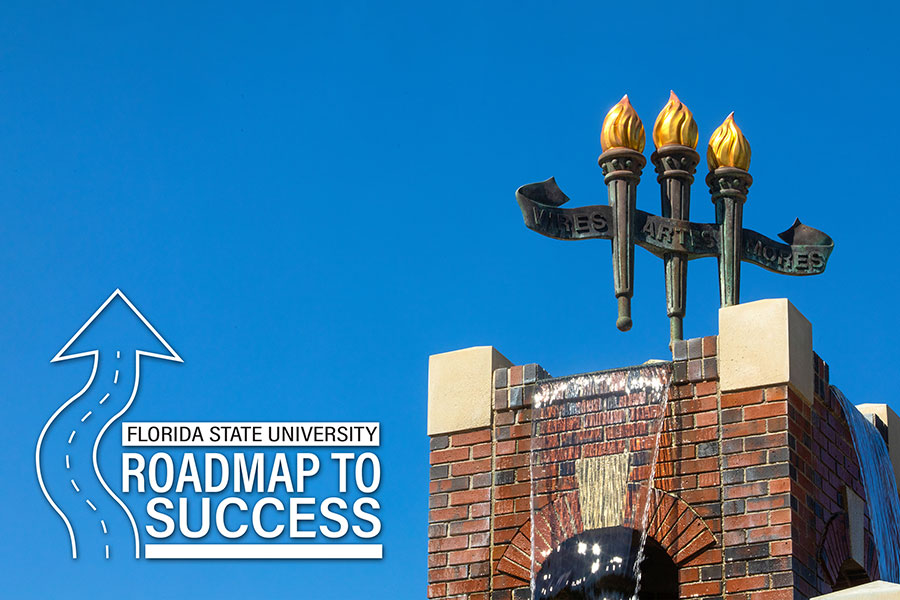
FSU’s Roadmap to Success Starts with its Strategic Goals
Goal I: Entrepreneurship and Innovation (E&I)
Goal II: Academic and Research Excellence
Goal III: Diversity and Inclusion
Goal IV-V: Student Success
- Student success is part of the plan and the culture at FSU
- ProfessioNole Ready course integration promotes career readiness
- InternFSU helps students land meaningful experiences
- New FSU students connect through new Nole2Nole Peer Mentor Program
- FSU Career Center job shadow program continues to grow
Goal VI: Excellence and Reputation
When Florida State University embarked on an ambitious five-year strategic plan in 2017, President John Thrasher made clear that it would not sit on a shelf.
Thrasher wanted to see a widespread campus effort to put the university’s strategic goals into action. Individuals across the university answered the call, and the result has been an unprecedented run of success for FSU.
“The strategic plan provided us with a roadmap to becoming one of the very best public universities in the country while staying true to our core values of student success and academic excellence,” Thrasher said. “We’ve come this far because we know where we are going, and the benchmarks we have put in place ensure that we stay on course.”
Florida State set some lofty goals at the plan’s inception in hopes of strengthening the university in the areas of entrepreneurship and innovation, academic excellence and research, diversity and inclusion, student success and reputation.
The wins have been big: FSU cracked the U.S. News & World Report Top 20 rankings, created the Jim Moran College of Entrepreneurship — the first stand-alone college of entrepreneurship in the nation, set a State University System of Florida record with a 74 percent four-year graduation rate, brought in record research funding and increased enrollment of underrepresented or ethnic minority students.
“We have made significant improvements, and in fact, have experienced great performance in the areas we focused on,” said Provost and Executive Vice President for Academic Affairs Sally McRorie.
While there have been some easily recognizable achievements over the past few years, McRorie said that she looks to the data to assess the university’s overall progress in terms of advancing its strategic goals.
“Without that, it’s a feel-good story but you don’t really know exactly what has happened,” McRorie said. “As with the rest of the decisions that we make in the Provost’s office, the focus on data is really important. We are very data-focused at this institution and have been for a long time. This is just building on that culture of figuring out how to measure performance — whether it’s good or bad— and then acting accordingly.”
McRorie charged Associate Provost Rick Burnette with overseeing the implementation process and tracking the 165 different metrics that identify measurable targets for each of the plan’s six goals and 17 key initiatives.
“Rick has really worked to oversee this process in a way that is inclusive of the different groups around campus,” McRorie said. “He takes advantage of the data analyses that Institutional Research prepare as we look at how we measure accountability.”
Like Thrasher, Burnette’s objective was to keep the plan from becoming another doorstop.
“Most organizations have strategic plans, but what is different here is the degree to which it is driving institutional advancements,” Burnette said. “In some regards, it’s been the backbone for the ascension of the university. It’s really emblematic of the data-driven, strategic approach the university has taken to improve itself.”
Burnette credits the people across campus who participated in committees to break down the plan’s six goals and select 17 actionable initiatives that were applicable to most areas of the university. More than 100 people were involved in the effort.
“We identified team leads for each goal and empowered them to engage faculty, students, staff, alumni and members of the community to identify meaningful outcomes and the tactics that would help us attain them,” Burnette said.
To improve accountability, Burnette and his team worked with the University Communications department to create a webpage that illustrates the breadth of the innovations and improvements — big and small — through an easy-to-use, visual presentation of the data.
“When we talk to students about the plan and show them the website, they are really impressed that the university is doing so much for them to be successful,” Burnette said.
The university’s top strategic goal was to focus on fostering a culture of entrepreneurship and innovation. Not only has FSU established the Jim Moran College of Entrepreneurship, but the number of bachelor’s graduates who took an entrepreneurship course has nearly doubled since the plan was implemented.
“In addition to having the opportunity to major in entrepreneurship, it’s important for students in any career path to understand entrepreneurship and how it might impact their future decisions,” McRorie said.
Student success is another principal goal that really speaks to the core of the university’s mission. Broad-based and targeted tactics in advising, tutoring and academic coaching have helped produce rising graduation and retention rates. FSU now has the highest four-year graduation rate in the university system’s history, as well a school-record 95 percent freshman retention rate.
And while there have been some incredible advances during the strategic plan process, FSU has no plans to rest on its laurels.
“We want to be as efficient and effective as possible in everything we do,” McRorie said. “This process reflects our careful attention to every decision that’s made involving resources, as each one directly or indirectly impacts the performance of our students, faculty and staff.”
For more information on FSU’s strategic plan, visit strategicplan.fsu.edu.




